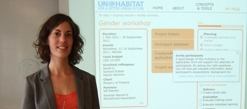Management Tool
Development of an Online Training Management Tool. A User Centered Approach to Capacity Development
Summary
Urbanization is an ongoing process all over the world, and in developing countries the growth of the urban population is particularly high. The rapid changes make the urban environment difficult to manage, and natural disasters as well as humanitarian crises make the situation even more complex
This project has been carried out as part of an internship at the United Nations Human Settlements Program (UN-Habitat) in Nairobi, Kenya. However, the views expressed herein do not necessarily represent the positions or opinions of UN-Habitat.
Among other things UN-Habitat is working with supporting capacity development for sustainable urbanization, by training national or local training institutions in related topics.
The institutes, in turn, train local authorities within their country, in order to strengthen the local capacity to manage the challenges of the cities. UN-Habitat has recognized that there is a need of supporting the institutes in developing effective training programs, for the training to make a difference to the work of the training participants and to ultimately have an impact on the urban environment.
After studying and analyzing different training processes of training institutions and the diverse contexts they work in, a concept of an online training management tool was developed and tested. The tool, an interactive website, was developed to support improved effectiveness as well as to make the training management more efficient.
The tool is combining theory on effective training with functions supporting implementation of theory in practice. A central function is an adaptable training project checklist, linked to theory on effective training, which provides the user with relevant information at any time of the training process. Other functions are project folders for organizing and sharing material and an online application form connected to a database where training participants can easily be managed.
A mock-up of the website was tested with two training institutes and one training consultant in Kenya. In addition it was evaluated by training experts at UN-Habitat. Both the training institutions and the experts believed that the tool would be valuable to the work of the institutes. Support for structuring the training process, coordination of staff members and prevention of unnecessary duplications of work were some of the perceived benefits.
Skriv ut ![]()


